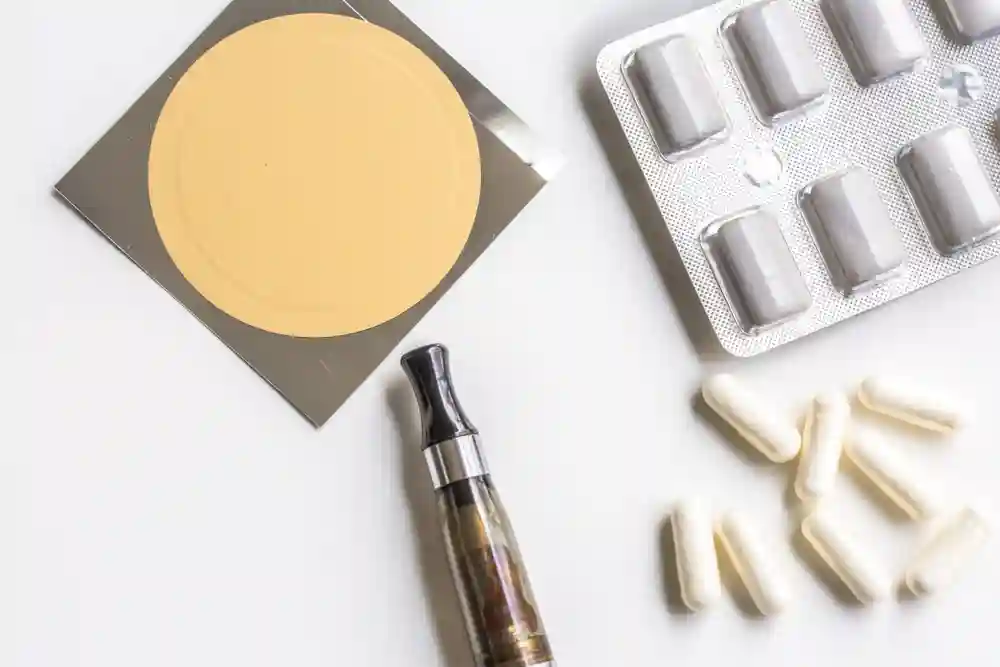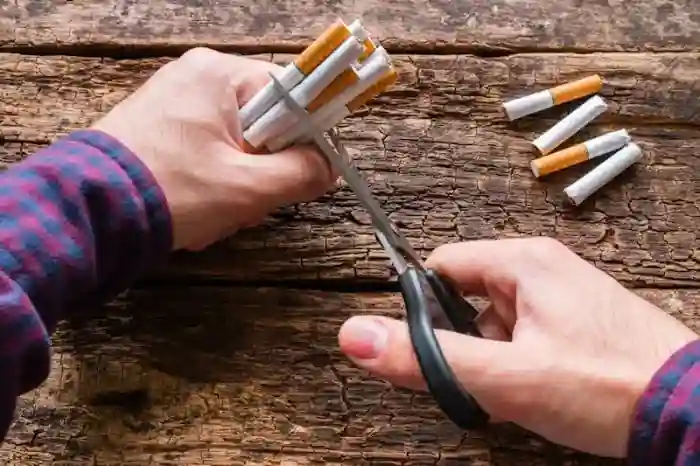
Quitting smoking is one of the most important steps you can take to protect your health. Whether you're ready to quit, need information on stop smoking, are using nicotine replacement therapy (NRT), or simply want to become smoke‑free, this guide will help you every step of the way. We'll explain the science behind tobacco, cigarette addiction, nicotine cravings, withdrawal symptoms, and how various quit‑smoking tools and products can help. We’ll also give you a clear roadmap—quit plan and resources to stay quit for good.
Quit Smoking: The First Step
Talking about quit smoking means facing a physical and psychological battle. To quit, you need to understand how tobacco, nicotine, and smoking cessation in adults work.
Why People Want to Quit
Many smokers decide they want to quit smoking after hearing about the harmful effects of nicotine and tobacco use on their bodies. Risks include lung cancer, heart disease, stroke, respiratory illness, and more. Moreover, second‑hand smoke affects loved ones, especially children.
The Role of Nicotine
Nicotine dependence is a major factor in attempts to quit. Nicotine enters your bloodstream through a cigarette and reaches the brain in about 20 to 30 minutes. It triggers pleasure, but also leads to addiction. When you stop using it, cravings and withdrawal symptoms begin.
Cravings and Withdrawal Symptoms
When you stop smoking, you may experience:
- Irritability and anxiety
- Increased appetite
- Difficulty concentrating
- Sleep disturbances
- Mood swings
These are common withdrawal symptoms and cravings that occur when your brain misses the steady dose of nicotine it was used to.
Nicotine Replacement Therapy (NRT)

Nicotine replacement therapy provides a steady level of nicotine without the harmful chemicals in tobacco smoke. These FDA‑approved tools can help you quit and stay quit.
Types of NRT
Nicotine Patch
The nicotine patch delivers a steady dose of nicotine through your skin over 16–24 hours, reducing cravings.
Nicotine Gum
Nicotine gum allows you to chew to release nicotine, which is absorbed through the lining of your mouth—a convenient method to manage sudden cravings.
Nicotine Lozenge
Nicotine lozenges dissolve slowly in the mouth, helping with oral fixation support and withdrawal.
Nicotine Nasal Spray
This fast-acting option delivers nicotine quickly and can mirror the rapid nicotine burst of a cigarette.
Nicotine Inhaler
An inhaler provides nicotine vapor you breathe in mimicking hand-to-mouth behavior and giving smoking tool for smoking cessation support.
How NRT Works

Using NRT means using nicotine replacement products to curb withdrawal symptoms and cravings while stepping away from tobacco smoke. It’s like a training wheel approach: slowly taper off nicotine until you're smoke‑free.
NRT can:
- Suppress nicotine cravings
- Reduce intensity of withdrawal symptoms
- Help form a quit plan
- Double the chance of quitting compared to going cold turkey
NRT products are approved by the FDA and considered a safe quit smoking tool by healthcare professionals, including the American Academy of Pediatrics and the Centers for Disease Control.
How to Use Nicotine Replacement Therapy
Creating a Quit Plan
- Choose your quit date
- Decide which NRTs you'll use (e.g., patch + gum for breakthrough cravings)
- Learn the proper technique—for gum, chew until tingling, then park between cheek and gum.
- Track usage in a journal
- Adjust dose over time to avoid too much or too little nicotine
Step‑by‑Step Use of NRT Products
Patches
- Apply to clean, dry skin in the morning
- Change daily, rotating sites
- Steps down in dose every few weeks
Gum
- “Chew, park, chew”—chew slowly until tingling
- Park for a minute until tingling subsides, then repeat
- Effective for sudden cravings
Lozenges
- Slowly dissolve in mouth
- Do not crush or chew—nicotine absorbs gradually
Nicotine Nasal Spray
- Dose is measured by sprays per nostril
- Can relieve cravings quickly; however, some find it irritating
Inhaler
- Puff like a cigarette, but no smoke or harmful chemicals
- Delivers nicotine to your mouth and throat
Stop Smoking Aids That Work
Besides NRT, other smoking medicines and tools can help. These are often used alongside NRT to increase success.
Prescription Medications
Varenicline (Chantix)
Reduces cravings and pleasure from cigarettes.
Bupropion (Zyban)
An antidepressant that also eases nicotine withdrawal symptoms.
Always talk to your health care provider about these options.
Behavioral Support
Counseling, quit lines, and support groups are critical. Many people combining medication with counseling have better success.
Digital Tools and Apps
There are quit‑smoking apps that track progress, send motivational reminders, and give tips (“your lungs are healing!”). Search your app store for “quit smoking app” or “smoking cessation aid.”
Want to Quit? Here’s What You Can Do
Preparing for Day One
Two Steps Before You Quit
- Get ready: List motivations and coping strategies.
- Talk to your health care provider about NRT, prescriptions, or counseling.
On Quit Day
- Remove all cigarettes and tobacco products from your home.
- Use your NRT as planned.
- Avoid triggers: coffee, liquor, stress, other smokers.
- Keep chewing gum, lozenges, a straw, or even toothpicks for oral fixation support.
- Drink water, eat healthy snacks.
Stay Quit: Long-Term Strategies
Handling Cravings and Withdrawal

- Cravings peak around 3–5 days after quitting and fade over 2–4 weeks.
- Try the 4 D’s:
- Delay: cravings pass in minutes
- Drink water or juice
- Deep breath
- Do something else (walk, call a friend)
Relapse Prevention
- Recognize high-risk situations: drinking, emotional stress, social events.
- Plan for slip-ups; don’t let one lapse lead to a return to regular smoking.
- Return to your quit plan and seek support.
Combining Treatments
- Some people use a nicotine patch and gum together.
- Or combine NRT with varenicline or counseling.
- Studies show combination methods often improve success rates.
Quit Smoking Tool for Smoking
There are various products can help, including low‑tech and high‑tech options.
Tools and Products
Button‑style Nicotine Inhalers
Provide oral and behavioral satisfaction like a cigarette without smoke.
Smartphone Apps
Track your smoke‑free days, money saved, health improvements.
Online Support Communities
Connecting with others can reduce isolation and strengthen resolve.
Buying Stop Smoking Aids
If you plan to buy stop smoking tools and products can help, here’s what you might look for:
Over‑the‑Counter (OTC) NRT
- Nicotine patches, gum, lozenges, all approved by the FDA.
- Packaged with instructions—follow dosage.
Online Shopping
- Sites like amazon.com often offer ✓ free shipping or ✓ free shipping on qualified orders for NRT.
- Look for category on amazon labeled “Nicotine Replacement Therapy.”
(Note: we are not selling these products—only providing options. Always check with your provider first.)
Harmful Effects of Tobacco and Nicotine
Understanding how smoking harms your body fuels determination to stay quit.
Immediate Effects
- Within minutes, heart rate, blood pressure, and breathing increase.
- Your body gets fewer nutrients and more carbon monoxide.
Long-Term Effects
- Lung cancer, COPD, heart disease, stroke, diabetes risk rise.
- Chronic illnesses: asthma, chronic bronchitis.
Effects of Nicotine
- Increases blood pressure and heart rate.
- May lead to insulin resistance and affect fetal development in pregnant smokers.
Side Effects of Quitting Smoking Suddenly
Quitting cold turkey can cause intense withdrawal symptoms:
- Cravings stronger
- Mood: irritability, anxiety, depression
- Sleep issues, appetite increase
- Physical: headaches, constipation, cough
If you want detailed insight into this, check our post on side effects of quitting smoking suddenly
Safe Quit Smoking Tool: Making Wise Choices
Why NRT Is Safer Than Smoking
NRT provides nicotine without the tar, carbon monoxide, and thousands of toxins in cigarette smoke.
FDA‑Approved Medications
Use products that are approved by the FDA, like the American Academy of Pediatrics recommends.
Health Care Provider Involvement
Your doctor or pharmacist can tailor a quit plan, advise proper dose of nicotine, and monitor health during the process.
Oral Fixation Support and Substitute Behaviors
Why Oral Fixation Matters
Many smokers miss the feel of a cigarette in their mouth. Replacing that habit can help with cravings.
Oral Substitutes
- Gum, lozenge, hard candy
- Toothpicks, straws
- Eating fruit or crunchy snacks
- Breath mints—clean your mouth without sugar
Statistics: Chance of Quitting
- Using NRT doubles your chance of quitting compared to placebo.
- Combining medication + support further increases success fair chance.
- Each individual’s journey is unique, but persistence pays off.
Quitting and Staying Quit
Tracking Progress
- Monitor days smoke‑free, money saved, improvements in breathing, energy, taste, smell.
Celebrate Milestones
- Treat yourself at 1 day, 1 week, 1 month, 3 months, 6 months.
Maintain Motivation
- Keep reminders of your reasons to stay quit: family, health, long life.
Helping Friends and Family – Encourage Them to Quit
If you're supporting someone who wants to quit smoking, you can help by:
- Encouraging them to talk to a health care provider
- Helping them create a quit plan
- Providing oral fixation support
- Celebrating milestones
Summary: The Way to Quit for Good
- Decide you want to quit tobacco and become smoke‑free.
- Talk to your health care provider.
- Use NRT, consider prescriptions like varenicline or bupropion.
- Plan for withdrawal symptoms and cravings.
- Use tools and support systems.
- Track progress, celebrate wins.
- Stay vigilant and reach out for help if cravings return.
Quitting smoking is the best investment you can make in your future. Every smoke‑free day brings major health benefits.
More Resources
Outbound Link
For additional guidance and support (non-commercial), visit this excellent blog from the American Lung Association:
“Quitting Smoking: Your Guide to Becoming Smoke‑Free” — this site offers science‑based, clear advice and community stories.
Next Steps
- Bookmark our page and check out our in-depth post on side effects of quitting smoking suddenly.
- Visit our official site: https://www.extremeantismokingsystem.com/ for tools, success stories, and free resources.
- Use nicotine replacement therapy, a quit‑smoking tool for smoking cessation, and build your support network.
Recap (Heads of Heads)
- summaries have covered patches, gum, lozenges, inhalers, sprays, prescriptions, apps, counseling.
- tips for patch use, gum method, lozenge rules.
- ideas: distractions like the 4 D’s (Delay, Drink, Deep breath, Do).
- subtleties: chewing gum until tingling, rotating patch site, acknowledging withdrawal peaks.
Final Thoughts
Quitting smoking is tough, but you can do it. With nicotine replacement therapy, proper support, and a solid quit plan, you can become smoke‑free for good. Your lungs, heart, and loved ones will thank you and the freedom you'll feel will be worth it.






